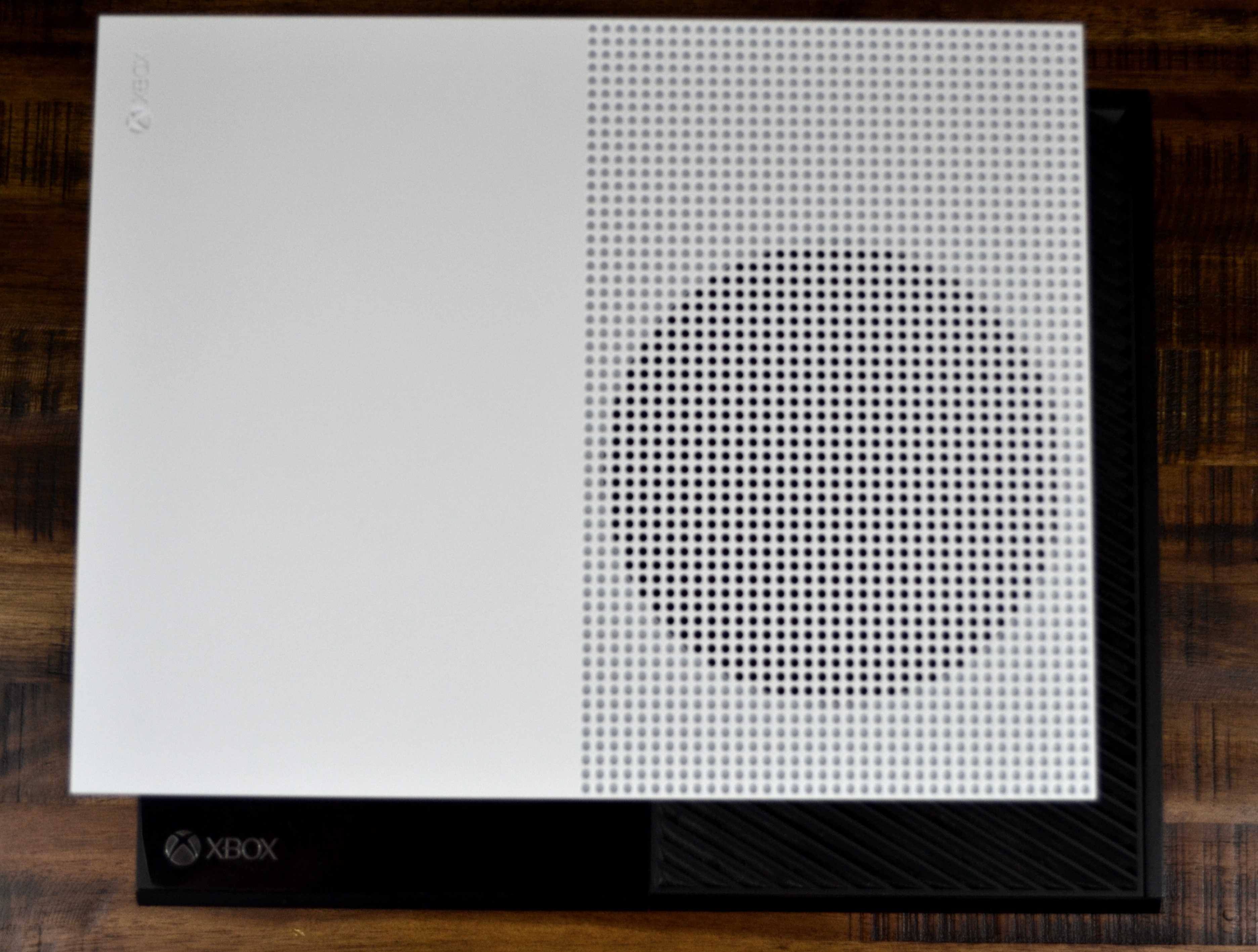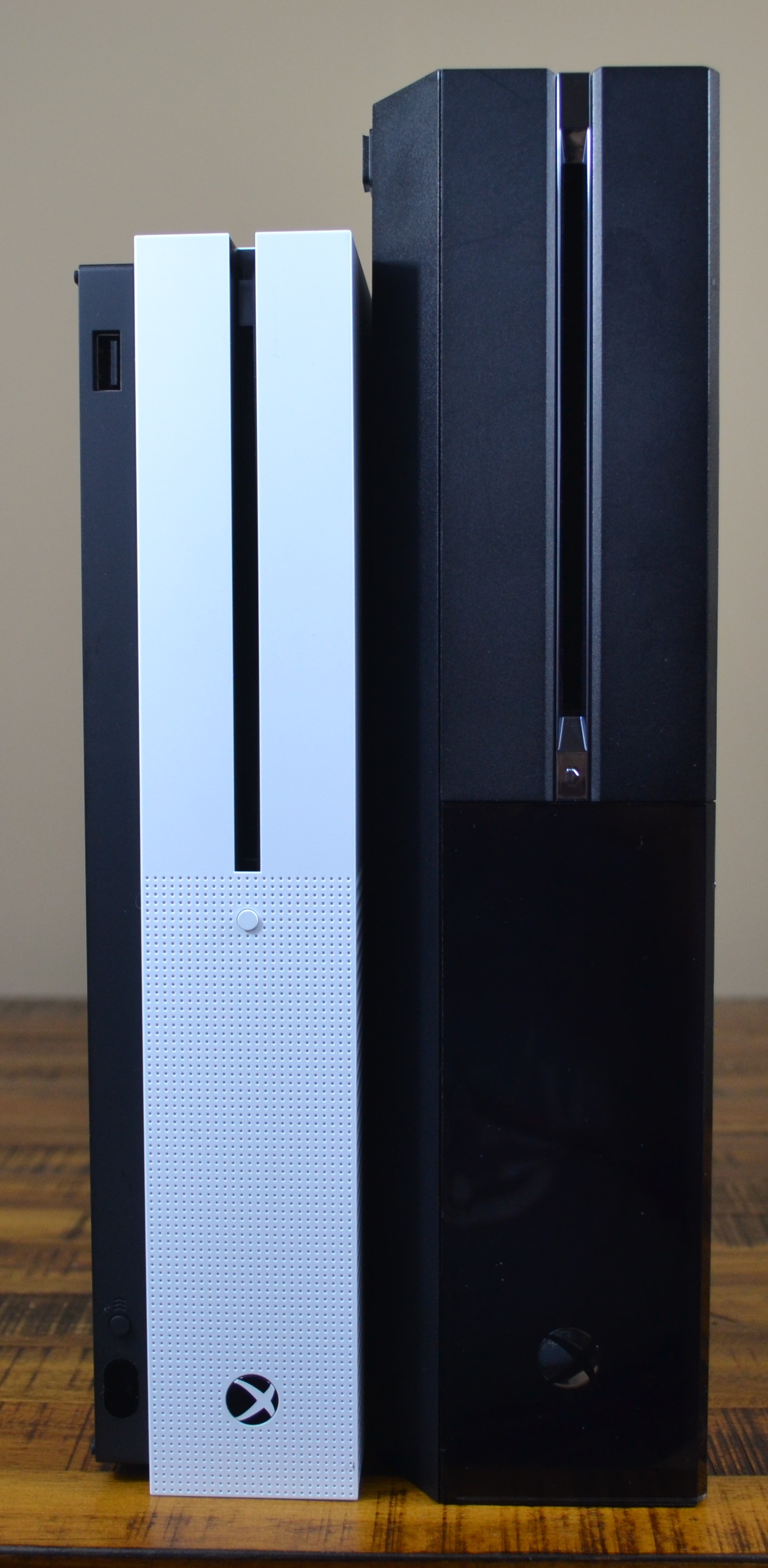The Xbox One S, Hands On
Less than three years after the release of the original Xbox One, Microsoft is out with a new version of its current console, the Xbox One S. Aside from the smaller size and updated controller, part of the new console's allure is its ability to stream 4K content, play back physical 4K Blu-ray discs, and use high-dynamic range (HDR) for videos and games. At launch, it seems that Microsoft delivered on the entertainment portion, but it will be a while until we know how the Xbox One S can handle HDR gaming.
What’s In The Box
Aside from the manual, the warranty book, and a free 14-day trial of Xbox Live, you can expect the usual suspects in terms of the box’s contents. There’s a power cord, HDMI cable, the controller (batteries included) and the console itself.
As for the main attraction, it’s slightly lighter than the original Xbox One. The Xbox One S comes in at about seven pounds, whereas the older version weighed closer to eight. Microsoft also ditched the black gloss coat and opted for the a matte white finish. Gone are the diagonal and angled vents for cooling, replaced by a series of circular holes on the sides, top and rear.
The rear of the console looks nearly identical to the old Xbox One, although the ports are more spaced out. The USB 3.0 port that was originally located on the left face of the console is now on the front of the Xbox One S, beneath the disc tray. The new IR blaster is located on the front, as well.




One absence from the Xbox One S' list of ports is the Kinect connection, but you can still use one on the new console. For those with an adapter, it will need to be connected to the first USB 3.0 slot on the rear of the console and then plugged into an outlet. Those with the Xbox One version of the Kinect can request a free adapter from Microsoft.
In the past, as well as part of today's launch post on Xbox Wire, Microsoft said that the Kinect port was eliminated to make way for the smaller form factor and integrated PSU. Even with the workaround, it seems strange that the elimination of one port would mean the difference between sizes for the console. The USB 3.0 ports could be placed in the front (similar to the two USB ports at the front of the PlayStation 4) to make space for the Kinect port in the back. There doesn't seem to be a worthy justification to remove the Kinect port, which makes me wonder if the Kinect's days are numbered.
One noteworthy improvement that I admired was that Microsoft opted for physical power and disc eject buttons instead of a touch-based surface controls. With physical buttons, you won’t accidentally turn the console on or off or eject a disc prematurely by grazing the surface with your finger.
Get Tom's Hardware's best news and in-depth reviews, straight to your inbox.
In keeping with the color scheme, the new controller is mostly white, save for the triggers and bumpers, which are still black. The peripheral obviously follows the design of the updated Xbox One controller, which added a 3.5 mm jack and a wider grip for your hands. However, it now has a textured grip so that your hands don’t slip. The underside of each grip features a small field of bumps, but they don’t seem to actually have any sort of benefit. I could clearly feel a different surface, but it didn’t provide any assurance that controller wouldn’t easily slip from my hand.
Because the Windows 10 Anniversary Update wasn’t available to me before today's launch, I wasn’t able to test the controller’s Bluetooth capabilities. However, it’s safe to say that Bluetooth implementation is a welcome addition, as you can use more devices with the Xbox Ones S without a special adapter than previous iterations of the console.
As an extra bonus, the console also comes with a vertical stand. The stand has two notches near its top that insert into two small holes on the underbelly of the console. Once the stand snaps into place, the Xbox One S is secured in its vertical position. However, it takes a bit of force to take it out again.
4K For Entertainment
With 4K playback as one of the more notable features for the Xbox One S, I used Netflix for the streaming test because it has more than enough 4K content in its original programming (including my new favorite show, Stranger Things). As expected, the Xbox One S delivered on 4K streaming with crystal-clear picture. However, prospective owners will need to have a sizable Internet connection speed (Netflix recommends 15 Mbps) to maintain 4K resolution playback. This, compared to 5 Mbps for 1080p HD.
Microsoft was also kind enough to include a 4K Blu-ray copy of the 2009 Star Trek film in order to utilize the 4K Blu-ray disc player. Compared to the Full HD Blu-ray version, the 4K variant had a slightly clearer picture overall. The presence of film grain is also less noticeable in 4K, although it’s not completely eliminated in both versions.
A Note On HDR Testing
The one thing I couldn’t test was HDR — which is supposed to provide a higher contrast between lights and darks — because I didn’t have an HDR-ready TV on-hand (for the record, my 4K TV is a Vizio P652UI-B2).
In terms of gaming, there isn’t a way to test out the new HDR features, because the three announced games that support the feature aren’t out yet. Scalebound should be out sometime in 2017, and Gears of War 4 isn’t due until October 11. The earliest chance to try out HDR gaming is when Forza Horizon 3 launches on September 27.
Wait And See
At launch, you’ll get to try out the 4K capabilities of the console, but the fact that it can play Blu-ray movies at the higher resolution is a major advantage for Microsoft. When the PlayStation 3 came out, Sony was able to provide a gaming and entertainment hub because it was the first console to support Blu-ray discs. Today, the PlayStation 4 and Xbox One can play Blu-ray movies in Full HD, but the Xbox One S is the first one to have 4K Blu-ray capabilities.
Having an Xbox One S in the living room could reduce the number of devices you'll need in your home theater setup, not to mention that its 4K abilities might encourage more people to pick up a 4K TV. Sooner or later, everyone will have a TV that supports 4K (as well as HDR), and the Xbox One S is a reasonable choice for a companion entertainment system.
However, HDR gaming is still a mystery. Microsoft should have released the console closer to the launch of an HDR-supported game so that fans could immediately try out the visual feature instead of waiting for an HDR-supported title. There’s also the (low) number of HDR games to consider. For now, there are just three games that support HDR, and it’s still unclear as to how many more titles will have it down the road. Unless your need to watch 4K content is high, there’s no reason to wait until Forza Horizon 3 arrives in September. Then, we can see if the Xbox One S is worth the gaming upgrade.
Rexly Peñaflorida is a freelance writer for Tom's Hardware covering topics such as computer hardware, video games, and general technology news.
-
cptnjarhead The new console does not support 4K gaming, only media playback and streaming. 4k gaming will be on the scorpion.Reply -
steve4king What about noise comparison between the One and the One S? (That integrated PSU has got to add more heat to the envelope)Reply -
James Mason Reply18372898 said:The new console does not support 4K gaming, only media playback and streaming. 4k gaming will be on the scorpion.
Unless it costs like $1000 dollars, I doubt it. -
jasonelmore is there any news on weather the APU in the Xbox One is using GlobalFoundries new 14nm process? i find it hard to belive they can cool the same 28nm chip with such a drastic size reduction.. this has to be shrinked silicon right?Reply -
James Mason Reply18373769 said:is there any news on weather the APU in the Xbox One is using GlobalFoundries new 14nm process? i find it hard to belive they can cool the same 28nm chip with such a drastic size reduction.. this has to be shrinked silicon right?
Maybe they just used a better cooling solution, it's definitely possibly to cool that small a package if they design it right. I notice that big circular vented area on the top, i hope that's the cooler.
Or maybe these things will run hot as hell and red ring themselves. -
Hellequin Does it natively render 4k graphics for gaming? No that is what the Scorpio will do.Reply
However it is reported to upscale current 1080p games to 4k like a 4k-bluray player would do for blurays. -
James Mason Reply18374440 said:Does it natively render 4k graphics for gaming? No that is what the Scorpio will do.
However it is reported to upscale current 1080p games to 4k like a 4k-bluray player would do for blurays.
That just means it can "stretch" the image to fit a 4k TV, so it's not a tiny 1080P box in the middle of the screen.
It'll probably look worse because it will fill in the other pixels with what it thinks is supposed to be there and not what actually would be. -
ien2222 I'm guessing with no mention of bitstreaming object-based audio, it definitely is a no go then?Reply

